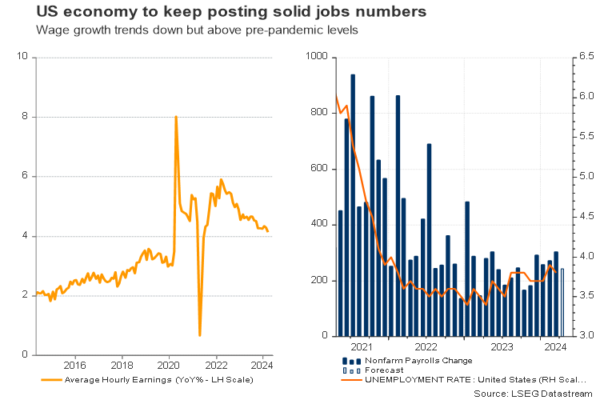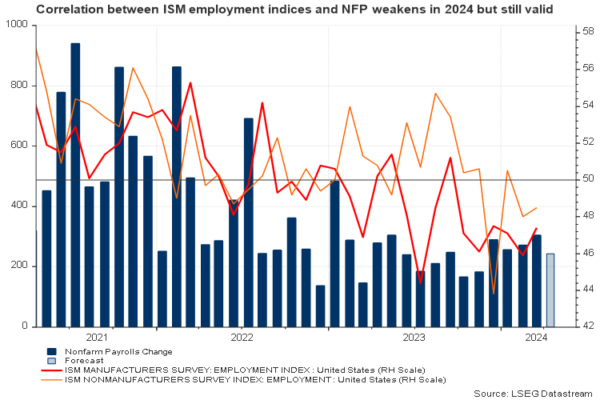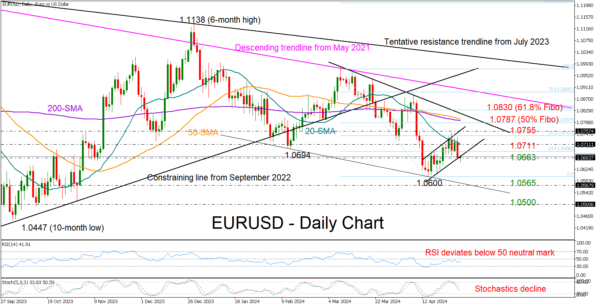- US nonfarm payrolls scheduled for release on Friday 12:30 GMT
- Another solid report could question rate cuts if Powell provides no clear guidance
- EURUSD at risk of plunging towards April’s low of 1.0600
April’s nonfarm payrolls might cause volatility
Friday will be a nonfarm payrolls day and investors expect the economy to have added 243k new job positions in April, keeping the unemployment rate steady at 3.8% and wage growth stable at 0.3% m/m.

The report will be the first release of the second quarter. Therefore, while the FOMC policy announcement may be the main event of the week, the data could still affect markets, particularly if Fed chief Powell offers no clarity on the rate path. Note that there will be no forecast updates during this week’s policy meeting.
Hotter-than-expected CPI inflation prints and signs of resurgence followed by hawkish Fed comments made investors think that the central bank will not cut interest rates as previously expected, at least not before November 2024.
Will Powell move the needle?
What is more striking is that talks for a rate hike resurfaced as some policymakers, including board member Williams, did not rule out the possibility of another increase. Of course, this is currently the least likely scenario, and policymakers might need inflation, and specifically the core measures, which exclude volatile food and energy prices, to shoot higher to confirm that the progress on inflation hasn’t only halted but that it’s also reversing.
Yet, with divisions growing within the board about the next rate action, Powell may not change his communication tone this week but repeat his recent commentary for “higher for longer” borrowing costs. However, if he does not provide further details such as how long will the central bank wait before it becomes confident inflation is sliding back towards the 2.0% target, traders might look at Friday’s jobs data for some direction.
Another solid jobs report expected
If forecasts are correct, April’s report may not generate any concerns about the US labor market. A growth of 243k compared to 303k in March would still be an outsize jump and perhaps an encouraging sign that the labor market can handle the increased migrant inflows, especially if the unemployment rate remains stable and below 4% for the 27th consecutive month – the longest stretch since the 1960s.
It’s worthy to note that the ISM business survey has been pointing to contracting employment conditions since the start of the year. But given its somewhat broken correlation with the NFP report and the healthy number of weekly initial jobless claims, there is little risk for employment growth disappointing significantly below 200k. Moreover, excluding the pandemic’s huge loss, April’s readings have been comfortably above that threshold since 2018. Perhaps if the Q1 GDP slowdown stretches into the next quarters, employers might start trimming demand for workers.

In other metrics, wage growth might attract special attention after the Bureau of Labor statistics revealed a higher-than-expected compensation increase of 1.2% in Q1 versus 0.9% at the end of December 2023. The annual change has stabilized at 4.2%, though this is still comfortably above the pace of 3.5% which the Fed considers more consistent with achieving its price stability target. Therefore, if April’s average hourly earnings surprise to the upside or appear more sticky, there will be less need for a rate cut.
EUR/USD levels to watch
With investors trimming their 2024 rate cut projections from three to hardly one over the past month, another upbeat jobs report could overall support the case for higher for longer interest rates, adding more fuel to the dollar’s rally.
Looking at EURUSD, the pair is currently trading at the lower boundary of a bullish short-term channel around 1.0663 after getting a rejection from the 20-day simple moving average (SMA) on Tuesday. The market does not look oversold according to the technical indicators. Hence, more downside might be on the cards. In this case, the door would open for April’s low of 1.0600, while lower, the sell-off might pause near the 1.0565 former restrictive zone and then around 1.0500.
Alternatively, a wide miss in the jobs numbers might help the pair crawl higher. If the 20-day SMA gives way at 1.0711, the price might find resistance near the channel’s upper band at 1.0755 before meeting the 50- and 200-day SMAs around 1.0787.










